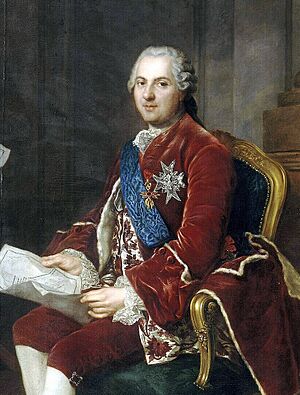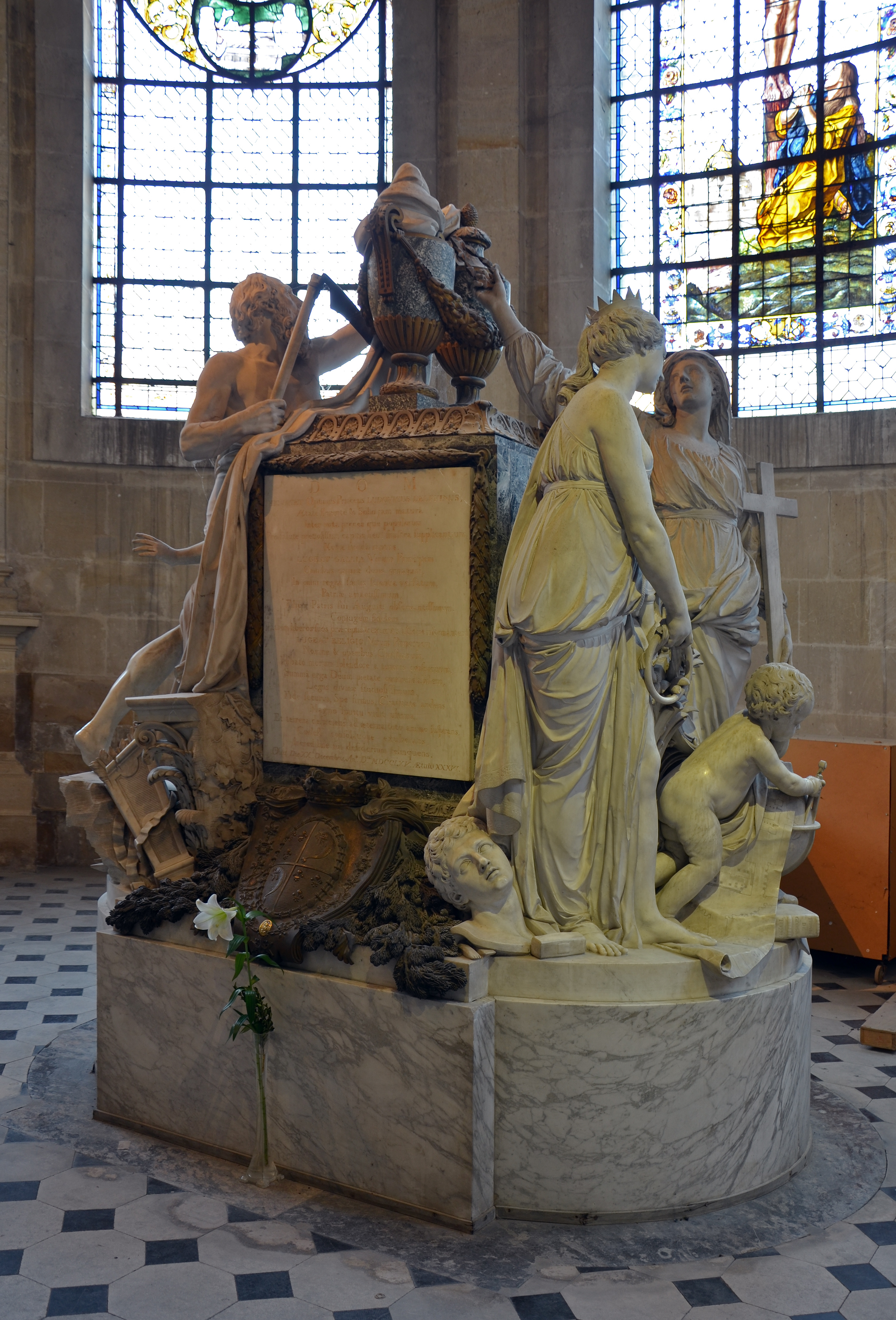Louis, Dauphin of France (1729–1765) facts for kids
Quick facts for kids Louis |
|||||
|---|---|---|---|---|---|
| Dauphin of France | |||||

Portrait by Anne Baptiste Nivelon, 1764
|
|||||
| Born | 4 September 1729 Palace of Versailles, Paris, France |
||||
| Died | 20 December 1765 (aged 36) Château de Fontainebleau, France |
||||
| Burial | Cathédrale Saint-Étienne de Sens Saint Denis Basilica (heart) |
||||
| Spouse |
|
||||
| Issue more... |
|
||||
|
|||||
| House | Bourbon | ||||
| Father | Louis XV | ||||
| Mother | Marie Leszczyńska | ||||
| Signature |  |
||||
Louis, Dauphin of France (born Louis Ferdinand; September 4, 1729 – December 20, 1765) was the only son of King Louis XV of France and Queen Marie Leszczyńska who lived to adulthood. As the king's son, he was known as a fils de France. Because he was the next in line to the throne, he became the Dauphin of France.
Louis died before he could become king. However, three of his sons later ruled France. These were Louis XVI (who reigned from 1774–1792), Louis XVIII (1814–1815, and again 1815–1824), and Charles X (1824–1830).
Contents
Early Life and Education
Louis's birth was very important. It made sure the throne would have an heir. It also made his mother's position at court more secure. Before Louis, she had given birth to three daughters. Louis had a younger brother named Philippe, but he died when he was a toddler.
Louis was first baptized in a private ceremony. He was given his full names, Louis Ferdinand, at a public ceremony on April 27, 1737, when he was seven years old. His godparents were his cousin Louis, Duke of Orléans, and his great-great-aunt, the Dowager Duchess of Bourbon.
His governess was Madame de Ventadour. She had also been his father's governess. When Louis was seven, the Duke of Châtillon became his governor. Jean-François Boyer, a former bishop, became his teacher.
From a young age, Louis was very interested in military skills. He was upset when his father did not let him join a military campaign in 1744. Later, his father became very ill. Louis went to his father's bedside, even though he was told not to. This made the king angry. Because of this, Louis's beloved governor, the Duke of Châtillon, was dismissed.
In 1745, Louis was allowed to go with his father on a military trip to Flanders. He saw the Battle of Fontenoy. After this, Louis was not allowed to fight in battles. This was partly because his father became more distant and jealous of him. Louis was very close to his mother and sisters, especially Henriette.
First Marriage
In 1744, King Louis XV arranged a marriage for his son. Louis was fifteen years old. He was to marry María Teresa Rafaela of Spain, who was eighteen. She was the daughter of King Philip V of Spain. The marriage agreement was signed on December 13, 1744. The wedding happened by proxy (meaning someone stood in for one of them) in Madrid on December 18, 1744. The couple then married in person at Versailles on February 23, 1745.
Louis and María Teresa Rafaela liked each other very much. They had one daughter, Princess Marie Thérèse of France. She was born on July 19, 1746. Sadly, María Teresa Rafaela died just three days later, on July 22, 1746. Louis was only 16 years old. He was very sad about losing his wife. But he had a duty to provide an heir for the French throne. So, he had to marry again quickly.
In 1746, Louis received the Order of the Golden Fleece. This was a special honor from his father-in-law, King Philip V of Spain.
Second Marriage
On January 10, 1747, Louis married Marie Josèphe of Saxony. She was fifteen years old. Her father was Frederick Augustus II, who was the Prince-Elector of Saxony and King of Poland. Their wedding was held by proxy in Dresden. A second wedding ceremony took place in person at Versailles on February 9, 1747.
Children
Louis and Marie Josèphe had many children, though some did not survive. Their children included:
- Stillborn son (January 30, 1748)
- Stillborn son (May 10, 1749)
- Marie Zéphyrine of France (August 26, 1750 – September 1, 1755); she died as a child.
- Louis Joseph of France, Duke of Burgundy (September 13, 1751 – March 22, 1761); he also died as a child.
- Stillborn daughter (March 9, 1752)
- Xavier of France, Duke of Aquitaine (September 8, 1753 – February 22, 1754); he died as a baby.
- Louis XVI of France (August 23, 1754 – January 21, 1793); he married Marie Antoinette and had children.
- Louis XVIII of France (November 17, 1755 – September 16, 1824); he married Princess Marie Joséphine of Savoy but had no children.
- Stillborn son (1756)
- Charles X of France (October 9, 1757 – November 6, 1836); he married Princess Maria Theresa of Savoy and had children.
- Marie Clotilde de France (September 23, 1759 – March 7, 1802); she married Charles Emmanuel IV of Sardinia but had no children.
- Stillborn son (1762)
- Élisabeth of France (May 3, 1764 – May 10, 1794); she never married and had no children.
Personality
Louis was a very educated person. He loved to study and enjoyed music. He preferred talking with people over hunting or going to parties. He had strong morals and was very devoted to his wife, Marie-Josèphe. He did not approve of his father's relationships outside of marriage.
Family friends wrote in their memoirs that Louis was very kind. Like his religious mother, he gave a lot of his money to help the poor. This made him popular with the French people. He was also very religious and supported the Jesuits. His sisters saw him as a perfect Christian prince.
Later Life and Death
Louis's father kept him away from government matters. Louis was part of a group called the Dévots. These were religious people who hoped to gain power when Louis became king.
Louis died from tuberculosis in 1765. He was 36 years old. He died at Fontainebleau, while his father was still alive. This meant Louis never became king of France. His mother, Queen Marie Leszczyńska, and his grandfather, Stanislaus I Leszczyński, also outlived him.
His oldest son who was still alive, Louis-Auguste, became the new dauphin. This son later became King Louis XVI when Louis XV died in May 1774.
Louis was buried in the Cathedral of Saint-Étienne in Sens. His tomb was designed by Guillaume Coustou, the Younger. His heart was buried at Saint Denis Basilica, next to his first wife.
Images for kids
-
Louis with his mother Maria Leszczynska, c. 1730
-
Louis de France at the age of 9 in a study with a globe and a fortification treatise, by Louis Tocqué
-
Masked ball at Versailles for the wedding of Louis, Dauphin of France, to María Teresa Rafaela of Spain, 1745
-
Allegory on the Death of the Dauphin by Louis-Jean-François Lagrenée, 1765
See also
 In Spanish: Luis de Francia (1729-1765) para niños
In Spanish: Luis de Francia (1729-1765) para niños








